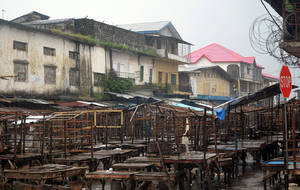Rome – Disruptions in food trade and marketing in the three West African countries most affected by Ebola have made food increasingly expensive and hard to come by, while labor shortages are putting the upcoming harvest season at serious risk, FAO on 2 September 2014 warned.
At the same time, the main harvest season for two key crops – rice and maize – is just weeks away. Labor shortages on farms due to movement restrictions and migration to other areas will seriously impact farm production, jeopardizing the food security of large numbers of people, the alert says.
Food Production Stands to Be Seriously Scaled Back
Generally adequate rains during the 2014 cropping season had previously pointed to likely favorable harvests in the main Ebola-affected countries. But now food production – the areas most affected by the outbreak are among the most productive in Sierra Leone and Liberia – stands to be seriously scaled back.
Likewise, production of cash crops like palm oil, cocoa and rubber – on which the livelihoods and food purchasing power of many families depend – is expected to be seriously affected.
“Access to food has become a pressing concern for many people in the three affected countries and their neighbors,” said Bukar Tijani, FAO Regional Representative for Africa. “With the main harvest now at risk and trade and movements of goods severely restricted, food insecurity is poised to intensify in the weeks and months to come. The situation will have long-lasting impacts on farmers’ livelihoods and rural economies,” he added.
Major Spikes in Food Prices
Guinea, Liberia and Sierra Leone are all net cereal importers, with Liberia being the most reliant on external supplies. The closure of some border crossings and the isolation of border areas where the three countries intersect – as well as reduced trade from seaports, the main conduit for large-scale commercial imports – are resulting in tighter supplies and sharply increasing food prices.
In Monrovia, Liberia, a recently conducted rapid market assessment indicates that prices of some food items have increased rapidly – for example, in Monrovia’s Redlight Market the price of cassava went up 150 percent within the first weeks of August.
“Even prior to the Ebola outbreak, households in some of the affected areas were spending up to 80 percent of their incomes on food,” said Vincent Martin, Head of FAO’s Dakar-based Resilience Hub, which is coordinating the agency’s response. “Now these latest price spikes are effectively putting food completely out of their reach. This situation may have social repercussions that could lead to subsequent impact on the disease containment.”
The depreciation of national currencies in Sierra Leone and Liberia in recent months is expected to exert further upward price pressure on imported food commodities.
Response Efforts
To meet short-term food relief needs, the UN World Food Programme (WFP) has launched a regional emergency operation targeting some 65,000 tonnes of food to 1.3 million people.
At the same time, FAO’s special alert says that “rapid assessments are required to identify the type of measures that are feasible to mitigate the impact of labour shortages during the harvesting period and for related post-harvest activities.”
And measures to revive internal trade are essential to ease supply constraints and mitigate further food price increases, it notes.
Preventing further loss of human life and stopping the spread of the virus remain the top priorities at this time. FAO has joined the coordinated UN effort to support affected countries, is in daily communication with WHO and other key actors, and has personnel in West Africa aiding technical and logistical efforts.
It is critical that rural communities understand which practices pose the highest risks of human-to-human transmission as well as the potential spill-over from wildlife. Toward that end, FAO has activated its networks of local animal health clubs, community animal health workers, producer organizations, forestry contacts and agriculture extension and rural radio services to help UNICEF and WHO communicate risk to affected populations.
*Source: FAO Release.
2014 Human Wrongs Watch






